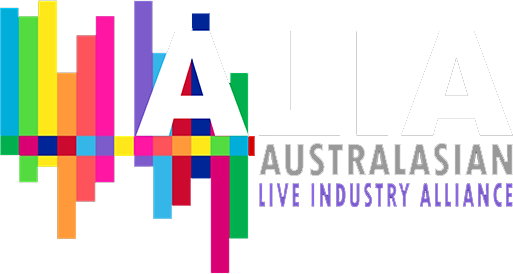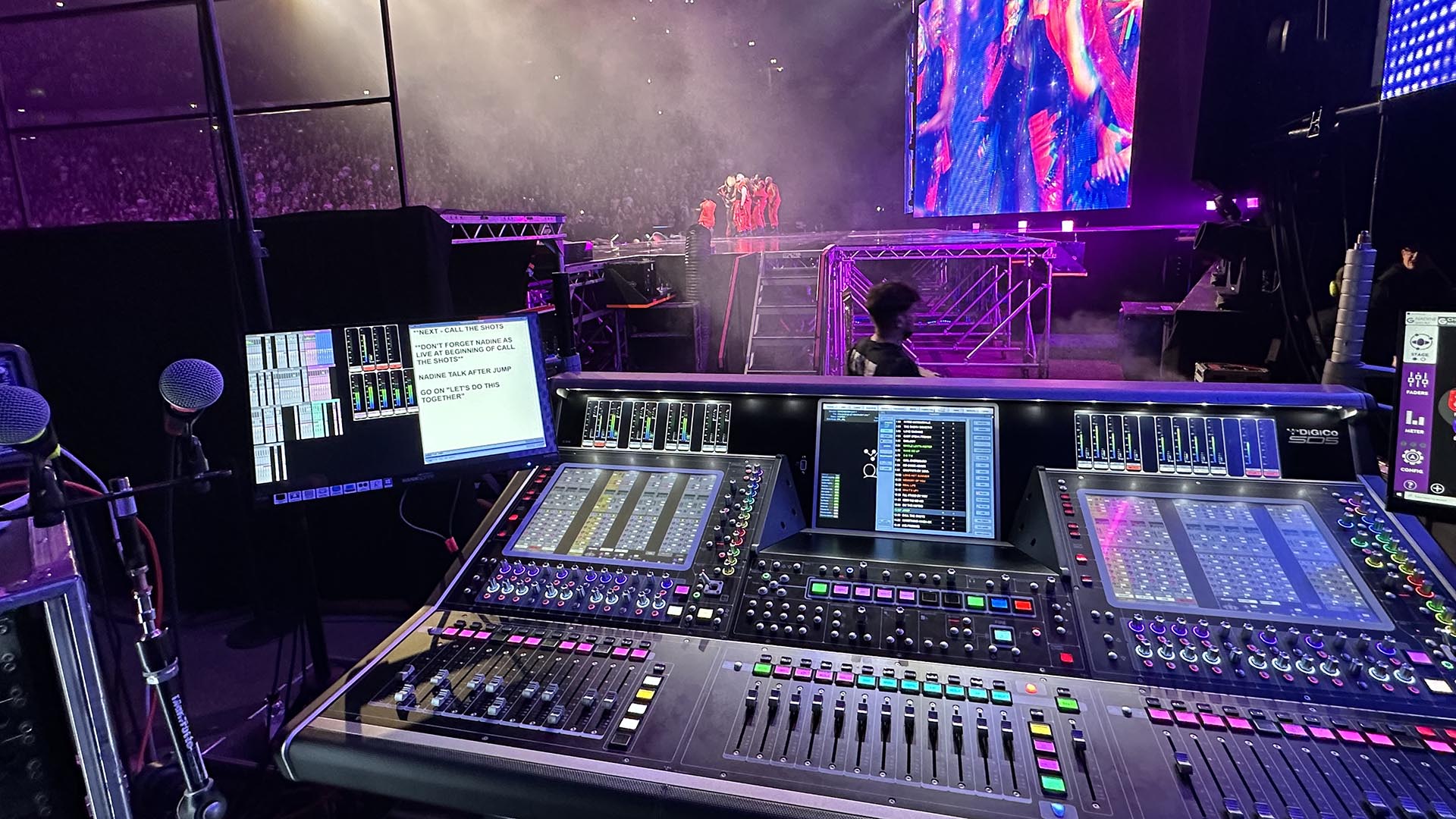FOH and Monitor Engineer Mike Osman lives in Brisbane working locally and internationally. He has just returned from Europe where he has been mixing monitors for Girls Aloud, the biggest UK arena tour of 2024 to date.

His audio career started in the early 90s in South Wales, playing in bands, and helping at a local music festival. In 1995 he started a small PA company Sound As A Pound doing a lot of the work for Swansea City Council in some of their venues as well as various gigs and festivals.
“In 2003 I was mixing a band called Karnataka, supporting Wayne Hussey,” said Mike. “Wayne heard me mix and liked what I was doing, so I ended up mixing FOH for The Mission for the next eight years. Over the years, I mixed either FOH or Monitors for various bands including Motorhead, Art Garfunkel, The Mission, Hundred Reasons, Snoop Dogg, The Sisters Of Mercy, and many more. Most recently, I’ve been mixing monitors for Anastacia, Katie Melua, Girls Aloud and McFly. I now live in Brisbane, after moving to Australia with my family in 2012.”

When in Australia, Mike freelances for a few companies, including NW Group, helping them with various gigs and festivals. He also does touring with bands who come over and need an engineer. He owns a DiGiCo SD9 which he has taken on a few smaller tours.
“The industry in Australia seems to be having a hard time this year, with some tour and festival cancellations,” Mike commented. “I hope it picks up for everyone again soon. I’m finding, not just in Australia but in Europe too, that since the pandemic, we have lost a lot of experienced people. Not just engineers and techs, but very noticeably in local crews. We had 60 locals for a load out a few weeks ago, and 90% of them had never done a show before. I’d be keen to see some structured training for people new to the gig world, so we can be confident that everyone knows how to do up a butterfly catch, lift a case etc.”
The Girls Aloud Show was the seventh concert tour by English-Northern Irish girl group Girls Aloud, with 30 shows across Ireland and the United Kingdom. It was Mike’s first time working with them as Monitor Engineer with Kevin Pruce mixing FOH.

Audio was supplied by Solotech UK out of their Manchester office (formerly Wigwam). Richie Gough was the System Engineer and Pete Hughes was the PA tech.
A d&b KSL PA comprising 20 boxes in each main hang and 16 boxes in each side hang was used. A couple of gigs also had 270 hangs which were V series. There were 8 x SL subs flown on each side, and some SL subs on the floor. A few V subs under the stage thrust complimented the front fills and evened out the coverage pattern. FOH console was a DiGiCo Quantum 338 with Waves and the system drive was a DirectOut Prodigy.
Mike was running a DiGiCo Quantum 5, fitted with a DMI-Klang card saying that the Quantum 7 and Quantum 5 are his two favourite surfaces to mix on.
“There wasn’t a 7 available, so I took a 5,” he added.” I’ve been using DiGiCo since the early 2000s, starting on a D5. Coming from an analogue world, they were the first digital consoles that made sense to me and worked the way I wanted them to. I was the first engineer to tour the SD8 when it came out in 2008 on a European tour with Art Garfunkel, and I’ve always had a good relationship with the guys at DiGiCo since then.”

On this tour, there was a DiGiCo at both ends, with an SD Rack each, all on one Optocore loop which included a DD2 for the playback system.
“It worked well because we could both pick up the playback channels and also have an analogue split between the SD Racks so we both had separate gain control of the vocal mics, ambients, etc.,” explained Mike. “The Quantum 5 is a great console. I was never in danger of running out of input or output processing channels, and there are plenty of fader banks on the first layer, so I can put all my inputs and outputs exactly where I want them, without having to switch layers or banks too often.”
Mike comments that the Klang integration was used the most on this tour adding that it’s so easy to adjust the 3D mix parameters from the work surface encoders and have all the Klang data saved as part of the DiGiCo session file. He also likes the Mustard VCA compressor, the Optical compressor on the Quantum desks and the Chilli 6 and Naga 6 in the Spice Rack.

Generally, Mike doesn’t use much outboard gear or plugin hardware preferring to use what’s on the console. For this tour, he took four channels of Neve 5045 Primary Source Enhancer for the girls’ vocals.
“In the big arenas, the crowd can be loud,” he said. “I think we hit 110dB of crowd noise a few times. That’s ok when the girls are singing, but when they move the mic away from their mouth, all that crowd noise gets into the mic and washes their mixes out. I found the 5045s helped reduce the background noise and sounded much more natural than traditional noise gates.”
Keeping the vocal balance right in each of the girls’ mixes is essential for Mike. He says they all have “more me” mixes, but also need a blend of all the other vocals for pitch and various cues. After that, it’s just about consistency and keeping things the same every day.

The most challenging part of the show for Mike is when the girls move from behind the PA to in front of it, and then back to behind it.
“Hardly any noise comes off the back of KSL, so there was a noticeable difference in the sound of their ears mixes when they moved from the main stage onto the thrust,” he said. “It was one of the first things they mentioned in production rehearsals, so I built some changes into my snapshots to help them when they moved in front of the PA.”
Everyone uses IEMs so Mike carried ten Shure PSM1000 systems with P10R packs.
“PSM1000s are my first choice of IEM. They are robust, and they sound great. It’s also easy to manage them with Wireless Workbench and an AD600 spectrum manager. Being able to scan the RF environment on stage with a belt pack, and then import that scan data into Workbench is very useful.”
At a few of the gigs where the quick change area was out of RF range, Mike ran a little powered speaker which just had some cues for them to hear time checks or specific instructions.
Vocal mics were Shure Axient Digital with six channels of receivers, all networked together with the PSM1000s, AD600, and all the battery chargers. AD2 hand-held transmitters in a nickel colour finish and KSM8 dual-diaphragm capsules were used.
“We chose the KSM8 to try and minimise the colouration differences when the girls were holding the mics in different positions as they were singing and dancing at the same time,” he added. “They work really well and we were both impressed with how good they sound.”
Mike returns to Brisbane this month where you can contact him at www.studiozz.com.au





















































